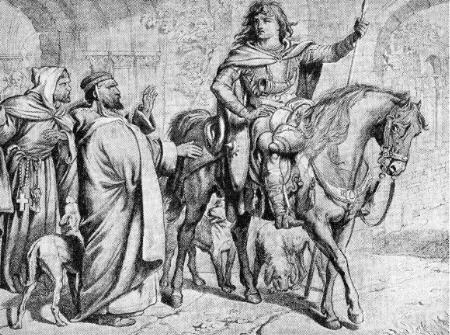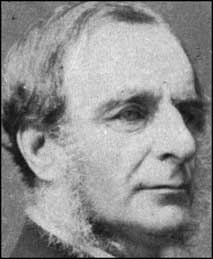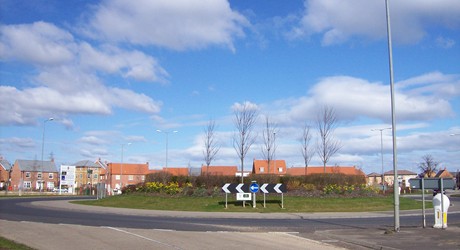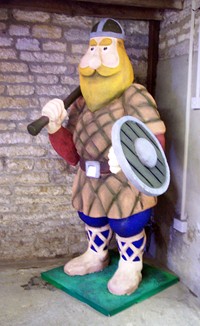|
Hereward the Wake
FLOURISHED 1070

Hereward leaving home after being outlawed - from a Victorian
engraving
The exploits of Hereward the Wake continue to delight and intrigue and Bourne has taken him to its bosom. But much of what we know today about this young Saxon outlaw is fiction and comes from the romantic historical novel Hereward the Wake, written in 1866 by the Rev Charles Kingsley (1819-1875), clergyman, novelist and poet, while staying at Edenham vicarage. He embellished the legends of the titular hero by painting him as a reckless gallant who for some time successfully opposed the Norman Conquest.
But although Hereward's story may be mainly fiction, his existence does have a solid core of truth. After the Battle of Hastings in 1066, William the Conqueror had little trouble imposing his rule on the country and most of Lincolnshire capitulated with little effort except in the fens and Kingsley makes great play of his hero's part in ridding Bourne of the Normans with a highly charged account of events that are straight from the realms of fiction.
A similarly colourful account of Hereward's exploits was written in 1926 by Christopher Marlowe (not to be confused with the 16th century dramatist of the same name) in his book Legends of the Fenland People in which he appears to have drawn heavily on Kingsley, and as these works were available in schools for several years afterwards and were used as teaching aids, which was my experience, this would explain why so many of the older generation today firmly believe in our hero's fictional rather than his factual pedigree and background. The conquest of England by William was bound to have its repercussions in every part of the kingdom but the changes in our county were mainly quite undramatic and peaceable. Two years after the invasion, William took possession of Lincoln, entering the city from the north. There seems to have been little resistance and the king allowed twelve lawmen to retain their powers in the town but he took the precaution of building a castle to overawe the citizens. Stamford appears to have been treated in much the same way and nine of its twelve lawmen remained and a castle was also erected. It is therefore likely that the arrival of the Normans in Bourne and its immediate neighbourhood was not accompanied by any great disturbance.
 |
Charles Kingsley,
classical scholar and Cambridge graduate, has done more than
anyone else to perpetuate the mythical tales about Hereward the
Wake that persist to this day. He wrote his famous book on the
Saxon hero while staying at Edenham vicarage during the mid-19th
century, inspired by local features such as Bourne Wood which he
used as the setting for his death at the hands of the Normans. |
Kingsley, who was a distinguished classical scholar and graduate of Magdalene College, Cambridge, had access to the great libraries of England and based his book on the romantic tales recounted in certain mediaeval chronicles, making Bourne the scene of his account of the resistance lead by Hereward and his supporters.
According to these tales, Hereward was the son of the Earl Leofric of Mercia and his wife Lady Godiva who owned the manor of Bourne and the castle
that reputedly stood in the Wellhead field which was Hereward's birthplace. After being outlawed for the rough treatment of certain monks at Peterborough, young Hereward is alleged to have had numerous incredible adventures in Britain and the Low Countries before returning home to challenge the Normans and clearing them from Bourne.
In May 1070, a Danish fleet had sailed up the River Ouse to Ely and the men of fenland joined it there to help in the Danish re-conquest of England. Hereward, the leader of this revolt, was then a Lincolnshire thane, the Anglo-Saxon title given to a member of the aristocratic classes who held land from the king or other noblemen in return for services rendered. He set up camp in the Isle of Ely and from there, with the help of the Danes, his men plundered and burned the abbey at Peterborough. He was joined by Morcar and Ethelwin, Bishop of Durham, and continued to lead a futile resistance against the Normans until 1071 after the Danes had withdrawn and sailed for home and eventually his supplies were blockaded by the Normans who laid siege to his camp of refuge which they overran three months later. Morcar and Ethelwin surrendered but Hereward managed to escape with some of his followers. He eventually made peace with William, an action that has somewhat lessened his reputation.
It is worth mentioning at this point the validity of mediaeval chronicles. This was the great age of forged charters, bulls and decrees. Early mediaeval men did not share our squeamish understanding of the nature of historical evidence. These documents did not always begin as deliberate forgeries but as the careful collection and expansion of remembered tradition, usually in the pursuit of proving ownership of land and chattels because the security of any community in Norman England depended on the possession of documentary evidence and when documents were lost or destroyed, they were replaced and as a result many have been found to have a large fictional content. The Chronicle of Crowland, a history of the monastery from the time of St Guthlac in 699 A D to the age of the Tudors, and one of the most important surviving mediaeval sources, is an example of such forgeries.
Hereward's life came under close scrutiny by historians in the mid-19th century when the noble lineage assigned to him was shown to be unfounded and it is now clear that there is no firm evidence to assume that he was a native of Bourne, nor to have been the son of Earl Leofric. In fact, in the reign of Edward the Confessor immediately prior to the Conquest, it was Earl Morcar, not Leofric, who was the principal landowner in Bourne. Hereward's origins and exact identity are shrouded in obscurity but he appeared to have had some connections with the area because the Domesday Book refers to him having held lands under the Peterborough fief at Witham-on-the-Hill, Manthorpe and Toft, as well as at Barholm-with-Stowe, these lands in 1086 having passed into the tenure of a knight called Ansford. Two other places which the Domesday Book connects with Hereward are Rippingale and possibly Laughton and it has been suggested that his attack on the abbey at Peterborough was not simply a buccaneering adventure but one designed to retain his lands after the Normans had appointed a new abbot.
He may therefore have been active in the locality during these years but his title of "the Wake" was bestowed by John of Peterborough and has no connection with the de Wake family who were to claim him as an ancestor. The de Wakes were Lords of Bourne at a later date and
tradition has it that they owned a large castle with two moats in the town where Edward III was entertained. This castle that once stood in the Well Head gardens was their stronghold. It consisted of a massive keep with square towers, a moat surrounding its low man-made mound and a second outer moat enclosing a bailey of almost eight acres. The moats were filled with water from Bourne's famous springs at the Well Head, or St Peter's Pool, issuing from a natural fissure in the limestone, and provided a safeguard against attackers but all that remains today is a maze of mounds. Given the prominence of the Wakes, it is natural that Hugh de Wake should sometimes be credited with founding an abbey at Bourne in 1138 although other accounts give the honour to his son-in-law, Baldwin Fitzgilbert.
The Wake name is perpetuated today by the Northamptonshire Wake baronetcy, created in 1621, but Sir Hereward Wake, the 14th baronet, was known to remark: "We used to be called Charles or Hugh or Baldwin until the family read Charles Kingsley." But what happened to Hereward? The chronicles suggest that he met an untimely death at the hands of the enemy in the woods near Bourne but this is also most unlikely. There is no conclusive evidence about Hereward's activities after his rout by the Normans in 1071 and his fate is unknown although ancient tradition suggests that he was buried in the chancel at Bourne Abbey but there is no evidence of such a tomb existing, any possible remains having been destroyed during demolition and reconstruction work in 1807.
Crowland Abbey also claims him and his wife Torfrida and perhaps his mother Lady Godiva but there is no firm evidence from this location either. It is most likely that he was buried in France because after he was pardoned by William, he accompanied him to Maine where he was murdered by the Normans. The research on Hereward leads us to conclusions very different from the traditional story yet the old legends are well rooted and refuse to die and it is doubtful if they will. An old tale well told is often more acceptable and far more enjoyable than the truth.
|
 |
|
A PUBLIC STATUE IS NEEDED
by Rex Needle
In March 2008, it was suggested by a member of the
public that a statue of Hereward be erected on the large grass roundabout
outside Elsea Park on the southern entrance to Bourne and received a
favourable response. Why not, indeed? Hereward is a combination of fact
and folklore but then many mythical characters are remembered around
England in this way, notably Robin Hood in Nottingham and Lady Godiva in
Coventry, and as with Hereward, their existence owes more to legend and
tradition than historical reality. Although his connections with Bourne
appear to be flimsy in the extreme, a statue would look good, a statement
in bronze or stone demonstrating that this community cares about its past.
Public support therefore would not be lacking but the money to make it
materialise would be difficult to find. Forget our local authorities which
are engulfed in never ending ways to raise more cash for salary and
pension entitlements for burgeoning staffs and so we must look elsewhere,
to fund raising by private individuals, grants from philanthropic
organisations and to donations from developers who have much to gain from
keeping this town firmly on the map in order to sell their houses.
Unfortunately, the biggest of these, Allison Homes, may also be discounted
from the equation because it has yet to fulfil the various amenities
promised under the planning gain for the 2,000-home Elsea Park estate.
The cost for such a project is likely to be expensive because sculptors
and foundries to cast the bronze do not come cheap. The Angel of the
North, for instance, the work of Antony Gormley and erected on the
outskirts of Gateshead in 1998, cost around £1 million but then this is a
massive 165 tons and as Bourne should aim for something less
adventurous, a figure of £50,000 might be more realistic. It is, perhaps,
merely a pipe dream, a flight of fancy, at this stage but then some of the
best ideas began as wishful thinking and today have become a fact. We
therefore live in hope. |
|
The only memorial of Hereward the Wake in the town is a
larger than life model of the Saxon warrior on display in the Heritage
Centre at Baldock’s Mill in South Street. It was presented for permanent
exhibition in March 2004 by the Church Farm Museum at Skegness where it
was on display the previous summer as a representation of Ulrick Sven who
was part of a Viking exhibition that ran from April to October and after
being moved 40 miles, the seven-foot high image made the transition from
Danish invader to Saxon rebel. The model was made by Steve Andrews, aged
37, from polystyrene and then coated with cement before being
hand-painted. It took him five days to complete but then Steve had a lot
of experience in this field. |
 |
|
He regularly designed and built the displays at
Christmas and other occasions for the Hildreds Shopping Centre at Skegness
where he worked as deputy manager. Hereward also speaks to visitors
because he is fitted a voice box, operated at the push of a button, when
he says: “My name is Hereward. Are you friend or foe? Do you want to trade
or fight?”
Members of the Civic Society who run the Heritage Centre created a theme
corner for Hereward on the ground floor by painting a mural on the wall
behind and adding some rustic furniture and so he can be seen standing in
a corner of olde England about to repel the Normans, with sword and shield
at the ready.
Our polystyrene model is about as shaky as the various myths that surround
him but then it is only a bit of fun. |
See
also
A biography of Hereward the Wake by William Marrat
1814-17
Hereward and the Barony of Bourne
Bourne Castle - fact or fiction?

Go to:
Main Index
|



